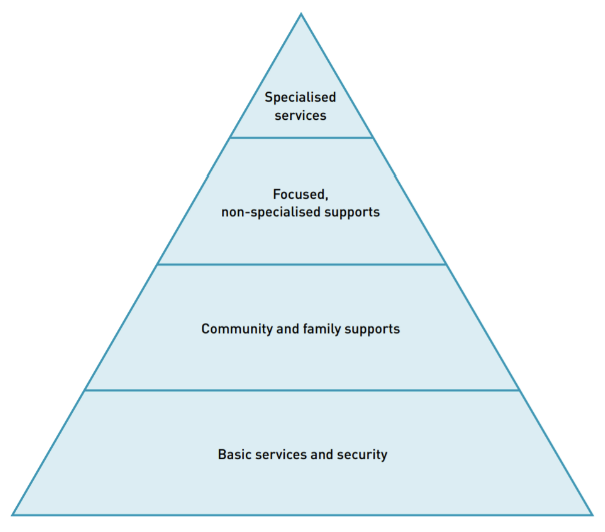Providing PSS-SEL Support for Learners During COVID-19
This article is part of a collection of blog posts related to the education in emergencies response to COVID-19.
PSS and SEL can facilitate and foster resilience, so they are vital services at this time, despite the increased challenges in delivery
Whether you are a practitioner experienced in psychosocial support (PSS) and social and emotional learning (SEL), or if you are looking to integrate PSS and SEL into your education programming for the first time, you will have likely gravitated towards this post because of the unique set of challenges brought about by COVID-19. Being faced with the unknown, there has never been a bigger sense of cooperation and collaboration as we are all looking to learn from one another, to help find our way through this unchartered territory.
INEE’s webinar on 16 April 2020 - Providing PSS-SEL Support for Learners During COVID-19 - gives a number of practical examples from various organisations who, just like you, are trying to find new ways to support students at a time when we aren’t able to gather in schools or learning spaces as before.
If you are relatively new to PSS and SEL (and even if you aren’t!) here are three INEE resources that provide an excellent starting point to underpin good practice:
-
INEE Background Paper on Psychosocial Support and Social & Emotional Learning for Children & Youth
- INEE PSS-SEL Training Module
In addition, you may have already seen the dedicated Mental Health and Psychosocial Support (MHPSS) collection of resources in INEE’s growing COVID-19 collection of open-source tools, guidance, and reports from across the network.
In short though, when we talk about PSS, we are talking about the processes and actions which promote holistic well-being. SEL, an important component of PSS, refers to the processes that foster the development of five core competencies:
- Self-awareness
- Self-management
- Social awareness
- Relationship building
- Responsible decision-making
So why is it important that we prioritize supporting the well-being of students at this time? Or focus on developing their skills such as self-management or social awareness?
Right now, nearly 90% of the world’s student population is out of school, meaning that nearly 90% of the world’s students are facing loss of learning, loss of routine, isolation from friends, and uncertainty about the future - as well as concerns over the virus itself, including threats to their health and the health of loved ones.
As we know, for some children and young people, school is much safer than home. The removal of this protective environment has vast implications beyond a disruption only to learning. Children and young people are facing multiple new sources of stress, and they need support to cope with this stress and build resilience.
Resilience is the capacity to cope with stress and adapt to challenges. Resilience happens when protective factors that support well-being are stronger than the risk factors that cause harm.
PSS and SEL can facilitate and foster this resilience, so it is vital that there is both a continuation of and increased access to these services at this time, despite the increased challenges in delivery.
Whatever the level of support you are seeking to provide to learners, here are four considerations to keep in mind:
1. Learning from what we already know
While we have never been faced with a crisis quite like this before, crises are not new to anyone in the humanitarian sector. You are some of the best placed professionals to demonstrate that all-important resilience - the ability to cope with stress and adapt to change. It is this adaptation of existing tools and resources that will be key in our responses. We - the wider education in emergencies (EiE) network - can utilize our existing knowledge and skills to meet this challenge. Now is a perfect time to learn from one another and share expertise.
2. Support parent well-being and teacher well-being
As we considered during the INEE practitioner well-being webinar two weeks ago, we are not able to support others if we don’t take care of ourselves first. We must acknowledge that parents are playing multiple roles in their children’s lives right now, and they too are affected by the stress and trauma of the crisis. Likewise, some teachers have to continue going into work, putting themselves at risk in order to continue providing education. We also know that when schools reopen, teachers will be at the forefront of providing psychosocial support to students and will be faced with the pressure of closing the educational gaps which will have inevitably emerged.
3. Centering equity and inclusion
In the humanitarian sector, we know that this virus is not ‘the great equalizer’ as some would have us believe. We know that it disproportionately affects those who were already marginalized. Having to adapt programming towards distance-learning measures, however, provides us with an opportunity to reach those who were already excluded from learning environments prior to the onset of the pandemic. When we center on those who are more readily excluded, it makes our services as accessible as possible.
4. Coordination with the health and the child protection actors
This is a multi-sectoral response, and there are limits to what PSS and SEL activities can do to support students with severe psychological problems. If you are familiar with the MHPSS intervention pyramid below, it is these top tier specialized services to which need to be able to make referrals. Familiarize yourself with who is doing what in Mental Health and Child Protection to ensure that those in need have holistic access to these services.
Finally, if you haven’t already done so, I highly encourage you to watch the recording of the INEE webinar on 16 April 2020 - Providing PSS-SEL Support for Learners During COVID-19 - to see some excellent examples of adaptive programming for PSS and SEL.



